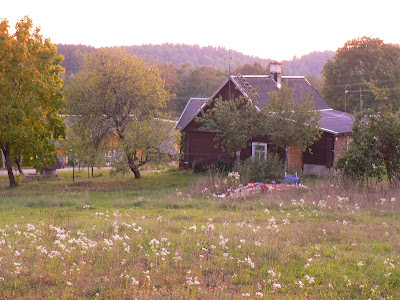And this is a national park in Lithuania?
 |
| Magda snoozes |
 |
| Riccas takes it easy |
 |
| Apples everywhere |
This little patch of paradise in Lithuania's Aukstaitija National Park (no, I can't pronounce it either) is a shock to the system.
As much as I love planning holidays, I've also come to appreciate that travel is all about the unexpected (preferably good unexpected) and challenging preconceived notions of what you'll find at your destination.
And given travel books, Google Earth, and online forums, it's especially nice to still be able to be surprised and delighted by a destination.
 |
| 19th Century watermill at Ginuciai |
I had expected a rural stopover between Lithuania's Vilnius and Poland's Warsaw as part of my small group tour of the Baltic countries (very small group as it turned out as there was just me, another traveller and our leader!).
I simply thought "OK. National park. Trees". Perhaps it would be a nice break before getting back to the "good stuff"?
But after just a few nights in the tiny village of Ginuciai, this stopover had entrenched itself as one of the most memorable experiences of the trip and of my travels so far.
 |
| The view from Ledakalnis Hill where you can see seven lakes in the 360 degree view |
Featuring 126 lakes in between small villages, forests and hills, Aukstaitija sits about 100km north of Vilnius. It's beautiful and wild, but not daunting or imposing.
 |
| Sunset in the small village of Ginuciai with Riccas the dog in the lead |
We stayed with an local elderly couple, Regina and Vlad (with their dog Riccas and cat Magda), who had kindly relocated to a "granny flat" out back so we could enjoy the comforts of their home.
Vlad stocked the fireplace and wood-fired sauna, from which we would then jump off their jetty into the lake. Regina cooked delicious meals that we washed down with vodka and apple juice.
 |
| Post-sauna splash into the lake |
All the more mystifying as to why this place is so special is the fact that there are few "major tourist attractions" here: a 19th century watermill, a bee keeping museum, lakes, streams and forests.
But perhaps that is part of its appeal. There's nothing to necessarily rush around and see. It's just a place to be.
More disturbingly, I started turning into an extra on the christian television commercial; I was canoeing, swimming, going for walks in the forest, and looking for mushrooms and berries. This place had really affected me.
 |
| Stream side in the Aukstaitija National Park |
 |
| Canoeing down a stream near the village of Ginuciai |
 |
| Canoe view on a lake in Aukstaitija National Park |
Unlike other national parks I had been to, this one felt very much "alive".
During the day, locals went about their daily business as you felt they had probably done for generations: harvesting crops, chopping wood and preparing for the approaching winter which would see snow once again blanket the region.
 |
| Houses in Ginuciai |
 |
| Ginuciai local in the garden |
But the little villages with brightly-coloured cottages occupied a fraction of the park's reach, with an expanse of ancient and untouched forests, lakes and streams on their doorstep.
While archaeological findings show people have lived in the area for the past 10,000 years, nature still holds the upper hand here. Apart from those people who live here, there's a regular influx of visitors from Vilnius who come for a day of walking or wild mushroom and berry hunting.
 |
| Forest walk to the bee keeping museum |
 |
| Mushroom spotting in the forest. I didn't eat this. |
 |
| Picking berries in the forest. I did eat these. |
 |
| Apples, apples everywhere. I ate these too |
 |
| Bee hives in tree trunks |
 |
| Artistic bee hives |
Whether it was the landscape, the people, the timing of my visit, or a combination of all these, this autumn Lithuanian surprise made me see the country in a whole new light.



No comments:
Post a Comment